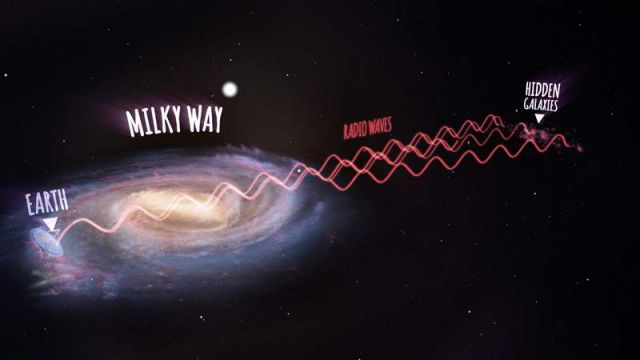Hundreds of new galaxies previously hidden on the other side of the Milky Way, have been discovered.
Above image: An artist’s impression showing radio waves traveling from the new galaxies in the ‘Zone of Avoidance’ behind our Milky Way galaxy, then passing through it and finally arriving at the Parkes radio telescope (not to scale). Credit: ICRAR
Despite being just 250 million light years from Earth, the new galaxies had been hidden from view until now by our own galaxy, the Milky Way.
Hundreds of hidden nearby galaxies have been discovered, explaining the mysterious gravitational anomaly dubbed the Great Attractor.
Using CSIRO’s Parkes radio telescope equipped with an innovative receiver, an international team of scientists were able to see through the stars and dust of the Milky Way, into a previously unexplored region of space.
The Great Attractor region, which appears to be drawing the Milky Way and hundreds of thousands of other galaxies towards it with a gravitational force equivalent to a million billion Suns.
This scene has been created using the actual positional data of the new galaxies and randomly populating the region with galaxies of different sizes, types and colours. Credit: ICRAR
Lead author Professor Lister Staveley-Smith, from The University of Western Australia, said the team found 883 galaxies, a third of which had never been seen before.
“The Milky Way is very beautiful of course and it’s very interesting to study our own galaxy but it completely blocks out the view of the more distant galaxies behind it,” he said.
Professor Staveley-Smith said scientists have been trying to get to the bottom of the mysterious Great Attractor since major deviations from universal expansion were first discovered in the 1970s and 1980s.
“We don’t actually understand what’s causing this gravitational acceleration on the Milky Way or where it’s coming from,” he said.
source icrar







Leave A Comment